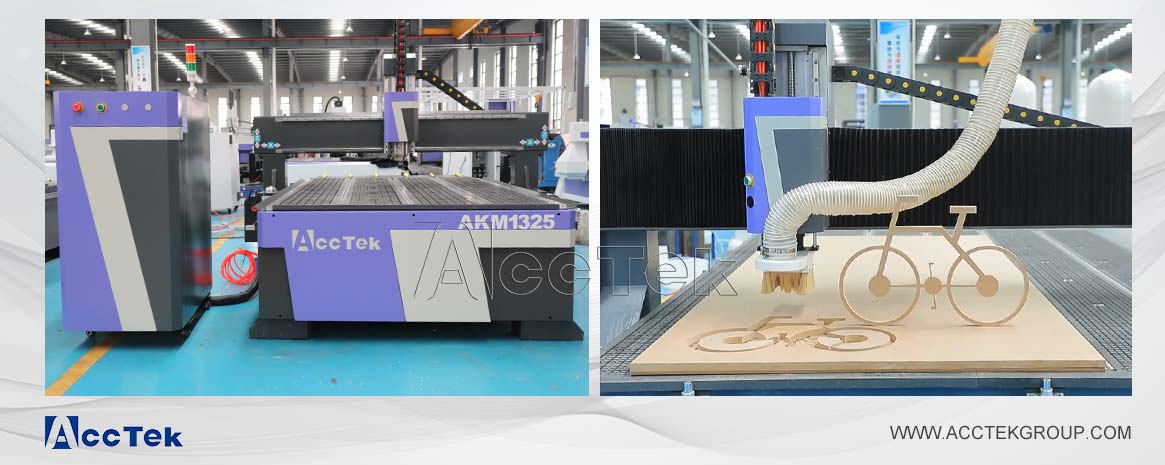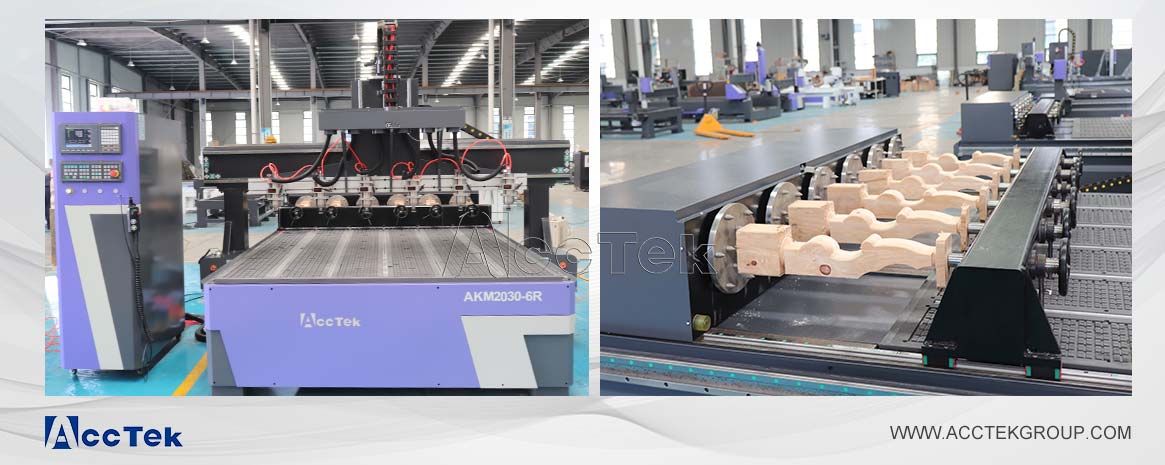CNC Wood Router with Rotary Axis: A Must for Cylindrical Wood
![[field:title /]](https://www.acctekgroup.com/templets/youben/images/shijian.png)
![[field:title /]](https://www.acctekgroup.com/templets/youben/images/zuozhe.png)
![[field:title /]](https://www.acctekgroup.com/templets/youben/images/cishu.png)
This article introduces 4th axis CNC routers with rotary axis that can be used for cylindrical processing. Understanding their characteristics and advantages will help you make the right choice of wood CNC router.
In the realm of woodworking, diverse projects demand precision and versatility. From crafting intricate designs to constructing durable furniture, the tools of the trade define the quality of the finished product. Among these tools, the wood CNC router stands as one of the most efficient and adaptable machines in the industry. However, when it comes to processing cylindrical wood, such as turning table legs, stair spindles, or decorative columns, the integration of a rotatry axis becomes indispensable. This feature transforms a standard CNC router into a tool capable of performing complex cuts on cylindrical workpieces, making it an essential asset for any professional or hobbyist woodworker.
Understanding the CNC Router and Its Functions
A CNC router is a computer-controlled cutting machine capable of high precision and repeatability. It can work with various materials like wood, plastic, metal, and composites. In woodworking, CNC routers are typically used for cutting, engraving, and carving intricate designs into flat wood panels.
Traditional CNC routers primarily operate on three axes: the X-axis (horizontal), Y-axis (vertical), and Z-axis (depth). These three axes are adequate for flat or slightly contoured materials, allowing for a range of 2D and 3D designs. However, when the project involves processing cylindrical wood, such as creating rounded or twisted designs, an additional axis, known as the rotary or fourth axis, becomes crucial.
What is the Rotary Axis in CNC Woodworking?
The rotary axis, also called the 4th axis or A-axis, adds a new dimension to CNC routing capabilities. It enables the CNC router to rotate the workpiece around its axis, allowing for continuous cutting, carving, and engraving on cylindrical or irregularly shaped objects.
Unlike the traditional 3-axis CNC router, where the router head moves along the X, Y, and Z planes, a CNC router with a rotary axis allows for the rotation of the wood while it is being processed. This rotation creates endless possibilities for symmetrical or asymmetrical designs on cylindrical wood. The rotating axis is particularly useful for applications like:
Turning Wooden Balusters: These are common in staircases, railings, and decorative pieces. A rotating axis allows for intricate detailing on these round components, adding to the aesthetic appeal.
Carving Wooden Statues and Sculptures: Sculptors who work with wood benefit greatly from the rotating axis. It permits precise, continuous carving around the entire circumference of a wooden cylinder.
Making Table Legs and Chair Arms: Furniture manufacturers rely on the rotating axis to produce uniform, detailed legs for tables and chairs. The axis allows for consistent replication of designs, ensuring that each leg matches perfectly with the others.
Crafting Wooden Columns and Poles: Decorative columns, often used in home and garden designs, require detailed carvings. The rotary axis provides the functionality to rotate and carve simultaneously, making it easier to achieve complex patterns that wrap around the entire structure.
Advantages of a Rotary Axis CNC Router
The integration of a rotary axis in CNC woodworking routers provides several advantages, making it a vital feature for woodworking projects requiring cylindrical processing. Here’s why:
Increased Precision and Efficiency: With a rotary axis, you can achieve greater precision when working on cylindrical objects. The rotation allows for smooth, continuous cutting, reducing the need to reposition the workpiece manually. This automation significantly enhances efficiency, making it possible to complete projects faster.
Consistent and Replicable Results: One of the key advantages of CNC technology is the ability to replicate designs consistently. A rotary axis allows for the consistent production of identical cylindrical parts, whether it’s for large-scale manufacturing or small-batch artisan projects.
Enhanced Design Flexibility: The rotary axis opens up new design possibilities that are otherwise impossible with a standard 3-axis CNC router. You can create more complex shapes, textures, and patterns around the entire circumference of a piece, expanding the creative potential of your work.
Reduced Labor and Manual Effort: Without the rotary axis, projects that involve cylindrical wood processing often require manual intervention, repositioning, or the use of specialized lathes. With a 4th-axis CNC router equipped with a rotary axis, the machine handles all aspects of the workpiece rotation and cutting, reducing the need for hands-on effort and improving workplace safety.
Versatility Across Multiple Projects: A rotary axis adds to the versatility of the CNC router. In addition to handling flat materials, the machine can switch seamlessly between flat and cylindrical pieces, allowing for a broader range of projects without needing additional machinery.
Choosing the Right 4th Axis CNC Router with Rotating Axis
When selecting a 4th axis CNC router with a rotary axis, several factors should be considered to ensure you are choosing the right machine for your specific woodworking needs:
Size and Capacity: Depending on the size of the cylindrical objects you plan to work with, you’ll need to choose a machine with the appropriate capacity. If you’re working on large columns or posts, ensure the rotary axis can handle the length and diameter of the workpiece.
Spindle Power: The spindle is responsible for driving the cutting tools. For projects involving harder woods or larger cylindrical pieces, a CNC router with a high-power spindle will ensure that cuts are clean and precise, without causing stress on the machine.
Software Compatibility: Ensure the CNC router’s software supports advanced 4-axis operations. Software that allows for easy programming and control of the rotating axis will make the machine more user-friendly and efficient.
Tooling Options: Different woodworking projects require different cutting tools. Ensure the CNC router you choose has the flexibility to accommodate various types of tools for cutting, engraving, and shaping cylindrical wood.
Durability and Stability: A sturdy machine frame is essential for ensuring the stability and accuracy of the rotating axis. Vibrations and shifts in the machine’s structure can affect the quality of the cuts, especially when working on detailed designs.
In the field of woodworking, the demand for cylindrical wood processing continues to grow, particularly in the production of furniture, staircases, and decorative elements. A CNC woodworking router with a rotary axis is indispensable for achieving the precision, efficiency, and versatility required for these projects. By automating the rotation and cutting of cylindrical wood, this machine opens up a world of design possibilities and ensures consistent, high-quality results. Whether you are a large-scale manufacturer or an artisan woodworker, integrating a CNC router with a rotary axis into your toolkit will undoubtedly enhance your woodworking capabilities.
AccTek CNC is a professional CNC router manufacturer known for delivering high-quality and reliable machines. We offer users a wide range of rotary axis CNC routers, designed to meet various woodworking and manufacturing needs. Whether you're working on cylindrical wood projects or require precision in your designs, our machines are built to offer enhanced performance, versatility, and durability. With AccTek's wood CNC routers, you can achieve excellent results, optimize production efficiency, and take your craftsmanship to the next level.
Product Directory
Copyright © Jinan AccTek Machinery Co.,Ltd



